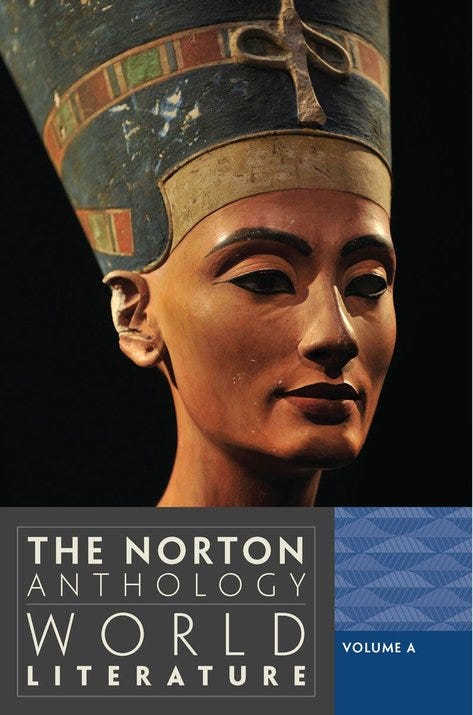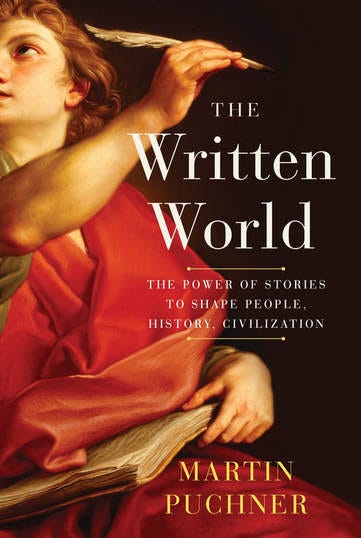Culture Is What We Make It—All of Us
A Conversation with Martin Puchner, Author of ‘Culture: The Story of Us, From Cave Art to K-Pop’
Few authors span the globe the way Harvard Professor Martin Puchner does. The lead editor on the ambitious and bestselling Norton Anthology of World Literature, he also teaches a popular Massive Open Online Course for HarvardX, Masterpieces in World Literature. Beyond that, he’s the author of seven books—most recently the award-winning and critically acclaimed Culture: The Story of Us, from Cave Art to K-Pop.
I’d read a prior book, The Written World, a couple years ago and raved about it to all who would listen. So, eager to read his newest, I dove into Culture at my first available opportunity. I was not disappointed. It’s an exciting tour of the world, looking at the cultural dynamics that enrich all our lives. You can read my review here. And you can read my conversation with him below.
We cover his approach to research, cultural appropriation, identity politics, and why we need more cultural borrowing, not less.
Miller: You cover so many different literatures and cultures in your work. How do you manage to extend and sustain your focus over so vast a terrain? And how do you manage the body of research your scouring uncovers and develops? From the outside, it would appear daunting. Is there a secret?
Puchner: Yes, it is daunting, no doubt about that, and sadly, there is no secret sauce, at least I haven’t found one. But the good news is that no secret sauce is necessary.
It’s primarily a matter of getting used to working at a certain historical scale. This can sound difficult because, well, it’s large, but also because training in the arts and humanities tends to focus on a scale of roughly 50–100 years, and often in a single region or state. It’s that narrowly focused training that makes the 50–100 scale feel “doable” to most scholars.
Now, some scholars have written terrific books on a single year. But very few work at the opposite end of the spectrum. But the thing is: none of these scales, whether one year, 100 years or 5,000 years are inherently easy or difficult to write about. It’s all about the kinds of questions you ask, and the kinds of case studies you use. So, I’ve been training myself to work on these large time scales, and I find that it gets easier the longer you do it, like most things.
What draws you to study and teach world literature, and how does that attraction affect your writing and teaching?
I think I’ve always been driven by curiosity, and I’m an impatient person, often eager to go on and discover something new. These are perhaps psychological prerequisites (or flaws). Having said that, I don’t think I would be working on world literature if it hadn’t been for the work on the Norton Anthology of World Literature, which started about eighteen years ago, quite by chance.

That’s when I first realized that we in the humanities so rarely work on larger time scales and how exciting it can be. I was forced to do it in the context of the anthology, discovered how interesting it was for me, and then decided to continue doing it. The reason why I find it interesting is that some of the most important questions about literature and culture can only be asked and answered on these larger scales: how does culture work; how often was writing invented; why do certain forms of cultural expression survive?
Where do you think the modern concept of cultural appropriation helps us as a society—and where does it hurt?
It seems to me that the term is used in a number of different ways. One (the most useful, in my mind) describes cultural borrowing in situations of extreme power imbalance. Here it can be used to make restitution arguments, for example with respect to Benin bronzes stolen by European colonists and displayed in Western museums.
At other times, “cultural appropriation” describes superficial or bad uses of culture, for example when students at Oberlin College complained about bad sushi and banh mi sandwiches. I think they didn’t really want to say that only Japanese people should be allowed to eat sushi—although the language of cultural appropriation they used made it sound as if that’s what they were saying—but that the Oberlin cafeteria should get its act together and make better sushi.
In a third case, the term is used to describe superficial uses of cultural practices made by celebrities (or corporations) for crassly financial motives, as when Beyoncé was dragged on Twitter for using henna tattoos without knowing much about this Indian tradition.
I and, I assume, many people are against the stealing of precious cultural objects—as well as against superficial or bad or crassly commercial uses of cultural practices. But I think that the term “cultural appropriation” is not the best way to avoid these bad outcomes because it excludes too much.
It also suggests that cultures are owned by specific groups or individuals and should be off-limits to others. This goes against the enormously productive function of cultural borrowing that I see at work in the history of culture. So I think we need to find a better, more nuanced, more precise way of avoiding these different bad outcomes.
It would be easy to see the multiculturalism of the 1990s as the direct antecedent of today’s identity politics, but there appears to be a significant difference: The prior view seemed to permit an implicit or explicit conversation between fundamentally equal (but nonetheless unique) cultures—a conversation which permitted cultural transmission and exchange. But the current conversation seems to stress each culture’s utter exclusivity, resulting in a form of unilateralism. Are there different drivers at play?
By asking about cultural exclusivity I think you’re thinking of “cultural appropriation” again. I agree. My problem with the broader, vaguer use of “cultural appropriation” is that it erects a lot of “hands off!” signs—signs claiming exclusive rights to cultural forms and traditions.
One problem is that if you look at any given culture, you realize very quickly that it was made of fragments of other cultures: it’s cultural borrowing all the way back in history. The other problem—in addition to the ones I outlined above—is that to my mind warning against “cultural appropriation” smacks too much of intellectual property rights, a recent invention in capitalism promoted primarily by corporations, such as the Disney Corporation.
“I think we need to get away from the idea that cultures can be owned by groups or individuals.”
—Martin Puchner
It’s always seemed strange to me that a certain leftist warning about cultural appropriation dovetails with these corporate positions; perhaps it’s a sign of how deeply the idea of property and ownership has sunk into our ways of thinking. Anyway, I think we need to get away from the idea that cultures can be owned by groups or individuals.

What means do you see to respond to patronizing or otherwise “inappropriate” cultural borrowing without appealing to cultural appropriation? Are there better tools in society’s toolkit?
Yes, that’s a crucial question and one I only have a partial answer to. The best I can do right now is to distinguish between the different uses of “cultural appropriation” and try to be more specific in each case about what we actually want to avoid.
When we are confronted with superficial uses of culture, we should worry about that and think about how to encourage more people to dive more deeply. When we are confronted with celebrities exploiting cultural practices, we should worry about celebrity culture and how to encourage more people to find other ways of accessing culture. When we worry about homogenization, we should think about better forms of borrowing, not shutting it down.
In each case, erecting a lot of “hands off!” signs doesn’t accomplish the goal as I see it, and can actually be counterproductive.
As a student of literature and culture, what are your hopes for cultural dynamism, short and long term?
There have been people who worry that our interconnected world will lead to homogenization. It’s yet another motivation, I think, for those warning against cultural appropriation. And again, I agree with the goal—I think homogenization would be a terrible outcome. The difference is that I just don’t see a lot of evidence that increased cultural borrowing is leading to homogenization. On the contrary, because borrowing has been the primary driver of cultural diversity and development, I would say that the opposite is the case.
“We need more cultural borrowing, not less.”
—Martin Puchner
Some people cite the “airport bookstore” as the kind of world we’re heading toward. First, I would say that in the last twenty years, the quality of airport bookstores has actually gone up quite a bit. Second, and more seriously, niche products and cultures have found new ways of thriving in an environment of intensive borrowing.
This isn’t to say that there aren’t homogenization pressures. For example, I worry about endangered languages (this is something I wrote about in a very small-scale book, The Language of Thieves). But my fundamental point is that cultural borrowing or “appropriation,” at least in the long-term, does not diminish diversity; it produces it. So, we need more cultural borrowing, not less.

What I would add is that we need to find better ways of cultural borrowing, ones that avoid as much as possible shallow, or exploitative, or crassly commercial borrowing that has always happened but that I agree should be diminished as much as possible.
How about your prognosis for modern liberal discourse, given the increasing role of identity politics—not to mention the stridency of its proponents—both in the academy and outside?
Hmm, that’s a difficult one. Even though the term “identity politics” is rather new, what it describes is very old, namely that humans use culture—from language and religion to food—to describe shared practices of one group against those of their neighbors, and by extension the rest of the world.
This happens on large geographic scales, between nations and empires and cultural regions, but also on smaller scales, within today’s nation states or from one village or neighborhood to the next. Politically, one might describe this as a struggle for resources. From a cultural perspective, as a struggle for recognition. All of this is in some ways inevitable.
At its best, liberal discourse describes an attempt to negotiate between identity groups and perhaps move beyond them. It doesn’t happen naturally. There isn’t a pre-existing neutral space or “middle ground” to occupy. It’s something that must be produced actively, deliberately, in each historical moment.
I don’t have a prognosis, more like a hope, and that is that we’ll find a way of making that project feel compelling to a critical mass of people, whether under the label of modern liberalism or some other term or mode.
“Liberal discourse describes an attempt to negotiate between identity groups and perhaps move beyond them. It doesn’t happen naturally. There isn’t a pre-existing neutral space or ‘middle ground’ to occupy. It’s something that must be produced actively, deliberately, in each historical moment.”
—Martin Puchner
In Culture, you cover a dizzying array of stories from all times and places. I’m betting you didn’t have room for all your examples in the final draft. What’s one story you wish you could have smuggled in?
Yes, there are so many. One of the cultures I think people should study much more is Maya culture. It’s the only completely independent writing tradition with a significant corpus of existing literature (before contact between Eurasian writing cultures and the Americas in the fifteenth century). This makes it an unbelievably interesting test case for all sorts of questions about writing technologies, literary genres, etc.
I left it out of Culture in part because I had written about it to some extent in a previous book, The Written World. But there is much more to be said about it. And new discoveries—about, for example, the extent of Maya cities—have been made just in the last two years. It’s a very exciting and lively area of research right now.

The other area I would have liked to spend more time on is oral literature and other immaterial cultural practices, especially in the performing arts, which was one of my original areas of specialization. They often fall by the wayside because they are more ephemeral and therefore require complicated, indirect forms of evidence and conjecture.
Right now, I’m expanding Culture into An Introduction to the Arts and Humanities, a textbook, and am adding lots of material. It’s great to have a second chance and much more space for added material. But still, even in that version of the book, which will be twice as large, you can’t cover everything.
Thanks for reading! If you enjoyed this post, please hit the ❤️ below and share it with your friends.
Not a subscriber? Take a moment and sign up. It’s free for now, and I’ll send you my top-fifteen quotes about books and reading. Thanks again!
Related post:




Such a great conversation. I'll definitely be looking for this book.
Loved this interview! Especially love the insights about homogenization and how borrowing from other cultures has actually produced the opposite effect throughout history.